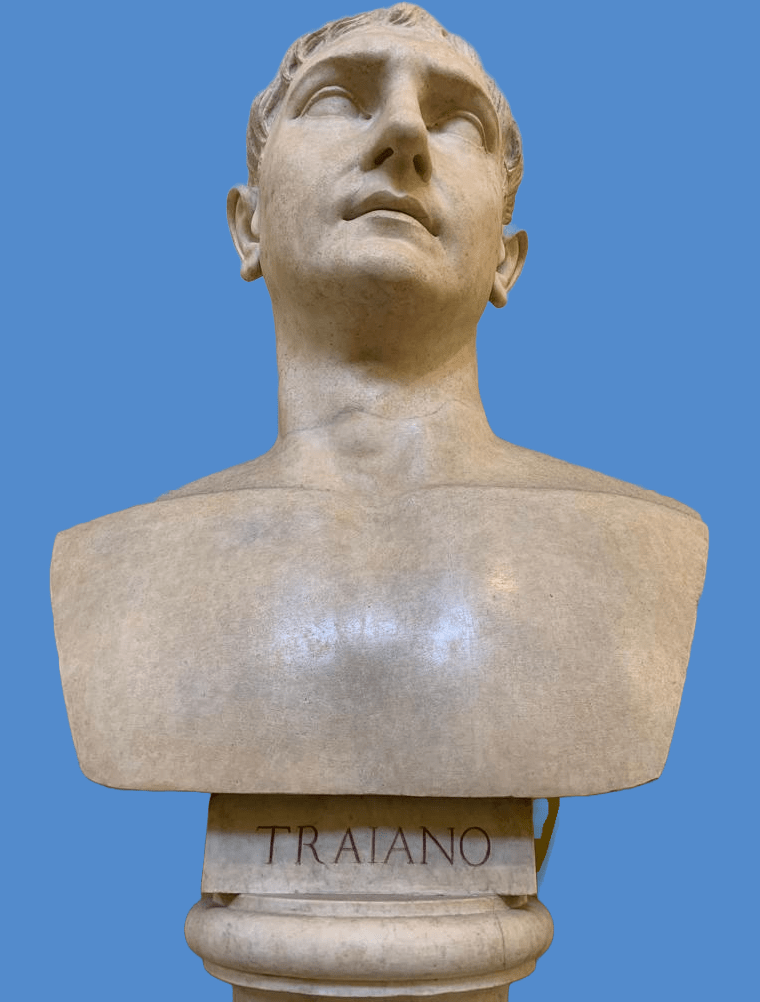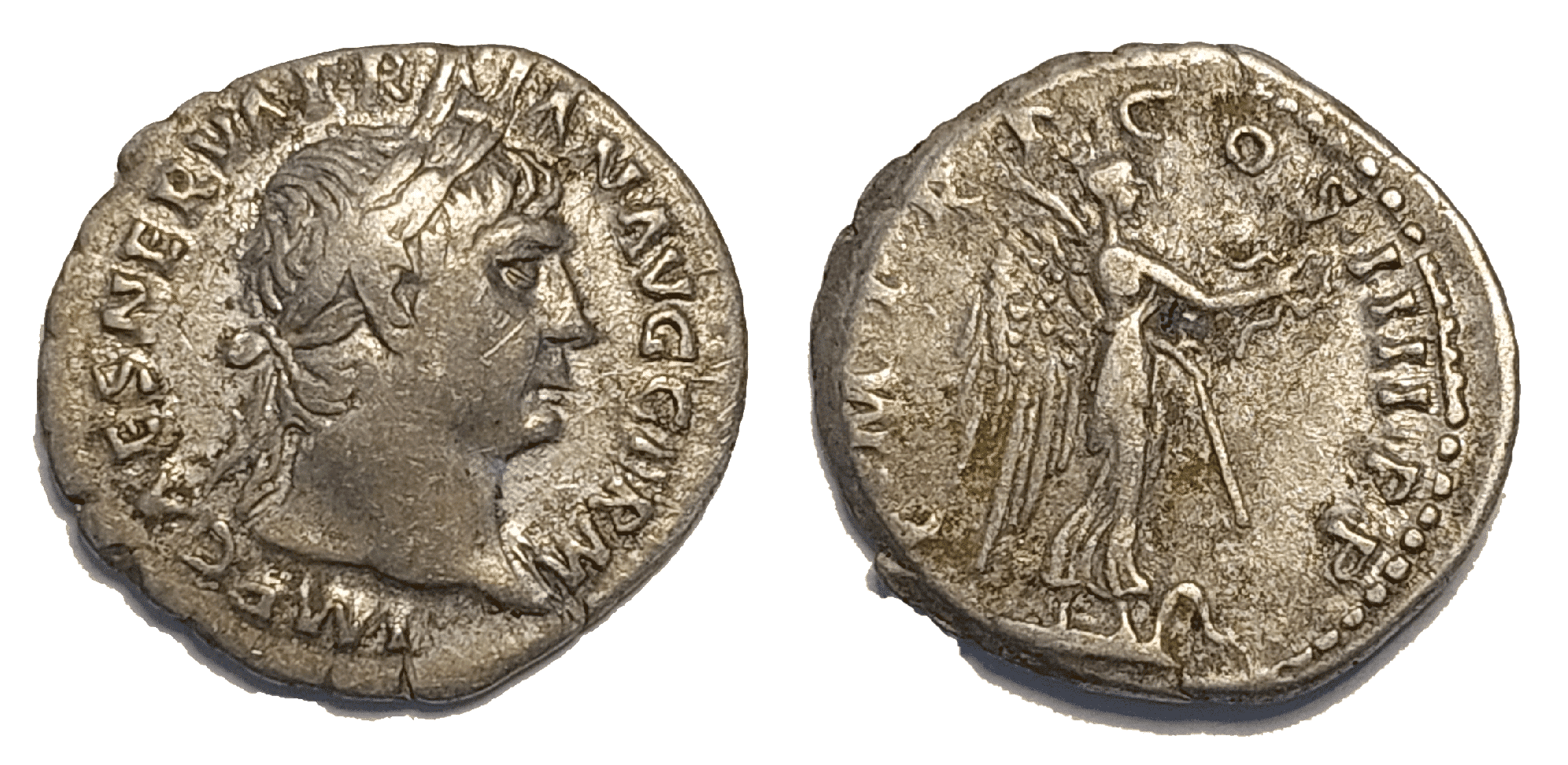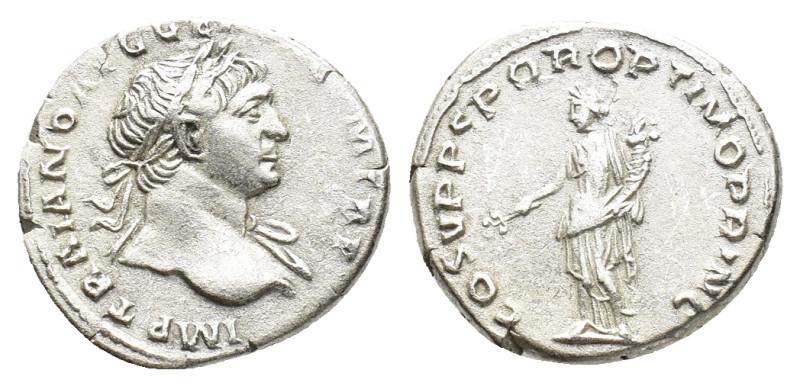His Story
Trajan was one of the most successful and respected Roman emperors, who ruled from 98 to 117 AD. He was born in 53 AD in Italica, a Roman colony in Spain, to a prominent senatorial family. His father, Marcus Ulpius Traianus, had a distinguished military and political career under the emperors Vespasian and Domitian. Trajan followed his father’s footsteps and became a soldier and a commander of legions in various provinces.
Trajan rose to prominence during the reign of Domitian, who was unpopular with the army and the senate. In 89 AD, Trajan supported Domitian against a revolt by Antonius Saturninus, a governor of Upper Germany. In 96 AD, Domitian was assassinated and succeeded by Nerva, an elderly and childless senator. Nerva faced opposition from the Praetorian Guard and decided to adopt Trajan as his heir and successor in 97 AD. Nerva died in 98 AD and Trajan became emperor without any resistance.
Trajan was welcomed by the senate and the people as a capable and benevolent ruler. He embarked on a series of military campaigns that expanded the Roman Empire to its greatest extent. He conquered Dacia (modern Romania) after two wars (101-102 and 105-106 AD), which brought immense wealth and glory to Rome. He also annexed Arabia Petraea (modern Jordan) in 106 AD, creating a new province. He then waged war against Parthia (modern Iran), Rome’s longtime rival in the east, and captured Armenia, Mesopotamia, and Babylon by 116 AD.
Trajan was not only a conqueror but also a builder and a reformer. He used the spoils of war to fund public works that improved the infrastructure and the welfare of the empire. He built roads, bridges, aqueducts, baths, markets, forums, temples, libraries, and monuments. His most famous construction was Trajan’s Column, a spiral relief that commemorated his Dacian victories. He also implemented social policies that supported education, agriculture, poor relief, and veterans’ pensions.
Trajan was regarded as an optimus princeps (“best ruler”) by the senate and the people. He was generous, tolerant, just, and loyal to his friends and allies. He respected the senate’s authority and consulted them on important matters. He promoted meritocracy and encouraged cultural diversity within the empire. He was also a patron of arts and letters and fostered a golden age of literature.
Trajan died in 117 AD while returning from his Parthian campaign. He fell ill in Selinus (modern Gazipasa), a city in Cilicia (modern Turkey), and passed away at the age of 63. His ashes were placed in a golden urn under Trajan’s Column in Rome. He was succeeded by his adopted son Hadrian, who had accompanied him on his eastern expedition. Trajan was deified by the senate and honored with the title of pater patriae (“father of the fatherland”). He is remembered as one of the Five Good Emperors who brought peace and prosperity to Rome.
Trajan rose to prominence during the reign of Domitian, who was unpopular with the army and the senate. In 89 AD, Trajan supported Domitian against a revolt by Antonius Saturninus, a governor of Upper Germany. In 96 AD, Domitian was assassinated and succeeded by Nerva, an elderly and childless senator. Nerva faced opposition from the Praetorian Guard and decided to adopt Trajan as his heir and successor in 97 AD. Nerva died in 98 AD and Trajan became emperor without any resistance.
Trajan was welcomed by the senate and the people as a capable and benevolent ruler. He embarked on a series of military campaigns that expanded the Roman Empire to its greatest extent. He conquered Dacia (modern Romania) after two wars (101-102 and 105-106 AD), which brought immense wealth and glory to Rome. He also annexed Arabia Petraea (modern Jordan) in 106 AD, creating a new province. He then waged war against Parthia (modern Iran), Rome’s longtime rival in the east, and captured Armenia, Mesopotamia, and Babylon by 116 AD.
Trajan was not only a conqueror but also a builder and a reformer. He used the spoils of war to fund public works that improved the infrastructure and the welfare of the empire. He built roads, bridges, aqueducts, baths, markets, forums, temples, libraries, and monuments. His most famous construction was Trajan’s Column, a spiral relief that commemorated his Dacian victories. He also implemented social policies that supported education, agriculture, poor relief, and veterans’ pensions.
Trajan was regarded as an optimus princeps (“best ruler”) by the senate and the people. He was generous, tolerant, just, and loyal to his friends and allies. He respected the senate’s authority and consulted them on important matters. He promoted meritocracy and encouraged cultural diversity within the empire. He was also a patron of arts and letters and fostered a golden age of literature.
Trajan died in 117 AD while returning from his Parthian campaign. He fell ill in Selinus (modern Gazipasa), a city in Cilicia (modern Turkey), and passed away at the age of 63. His ashes were placed in a golden urn under Trajan’s Column in Rome. He was succeeded by his adopted son Hadrian, who had accompanied him on his eastern expedition. Trajan was deified by the senate and honored with the title of pater patriae (“father of the fatherland”). He is remembered as one of the Five Good Emperors who brought peace and prosperity to Rome.
(Bust of Titus, Rome 2023, Picture by Juan Carlos Oviedo)





